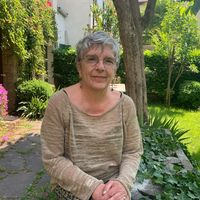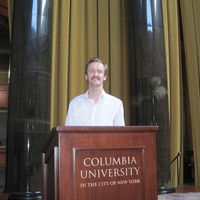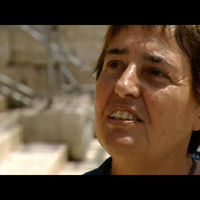Prizes by Mattia Guidetti

Syrian Studies Association 2017 Book Prize
2017
Book:
Mattia Guidetti, In the Shadow of the Church: the Building of Mosques in Early Medieval Sy... more Book:
Mattia Guidetti, In the Shadow of the Church: the Building of Mosques in Early Medieval Syria (Brill: Leiden, 2016).
Mattia Guidetti's In the Shadow of the Church: the Building of Mosques in Early Medieval Syria is an extremely important contribution to the history of medieval Syria and addresses a key, long-recognized lacuna in Islamic art history: the integration of the narrative of Islamic art with that of the art of Late Antiquity. It argues against a paradigm of "rupture" with the coming of Islam by successfully demonstrating that Early Syrian mosques were deeply influenced by Late Antique Church forms, and that the development of the mosque should thus be viewed as arising out of Church development in the period immediately prior to the rise of Islam. While a handful of historians have successfully integrated the history of early Islam into the world of Late Antiquity of which it was clearly a part, this is one of the first, and to date the most sustained, attempts to do so within the field of Art History. The committee was particularly impressed by Guidetti's exploration of the premodern mechanisms of coexistence among religious communities in medieval Syria. Likewise, Guidetti's contribution to the study of cultural transference of ideas and objects via his examination of spolia-architectural elements reused from earlier Roman and Christian-era monuments was outstanding. Guidetti's rich and deeply researched book opens a new chapter in the field of the Art History of Syria and promises to remain influential for years.
Books by Mattia Guidetti

During the early modern period, fruitful diplomatic exchanges alternated with periods of war betw... more During the early modern period, fruitful diplomatic exchanges alternated with periods of war between European states and the Ottoman world. In the Italian peninsula, at the local level, interactions were ambivalent: traders from Ottoman lands enlivened fairs and markets, while the continuous raids by corsairs constituted a calamity for coastal communities. The volume presents a little-known aspect of the complex relations between the Italian peninsula and the collectively defined "Turkish" world: the donation of war trophies to churches and sanctuaries as votive offerings. Through the study of artifacts and archival documents, the author reconstructs the epigraphic and iconographic program of seven standards that were relocated along the Adriatic coast of the Papal State, illustrating the various phases that characterized the reception of trophies and emphasizing the importance of certain flags as objects of study for early
Orientalism.
Durante la prima età moderna tra stati europei e mondo ottomano proficui scambi diplomatici si alternavano a periodi di guerra. Nella penisola italiana a livello locale le interazioni erano ambivalenti: commercianti dalle terre ottomane animavano fiere e mercati mentre le continue incursioni da parte dei corsari costituivano una calamità per le comunità costiere.
Il volume presenta un risvolto poco conosciuto delle complesse relazioni tra la penisola italiana e il mondo che collettivamente era definito come “turco”: la donazione di trofei di guerra a chiese e santuari come ex voto. Attraverso lo studio dei manufatti e di documenti d’archivio, l’autore ricostruisce il programma epigrafico ed iconografico di sette stendardi che furono ricollocati lungo la costa adriatica dello Stato della Chiesa, illustrando le diverse fasi che caratterizzarono la ricezione dei trofei e sottolineando l’importanza di alcune bandiere come oggetto di studio per il primo orientalismo.
Introduzione
1. Il contesto storico e geografico: la frontiera adriatica, Loreto, Vienna e gli Ottomani
1. La frontiera adriatica
2. Loreto
3. Vienna
2. Gli stendardi ottomani nelle Marche
1. Loreto
2. Fano
3. Urbino
4. Ostra
5. Osimo
6. Spelonga
7. Ulteriori trofei
3. Iconografia e comparazioni degli stendardi
1. Elementi iconografici
2. Raccolte europee di bandiere ottomane e comparazioni
3. Trofei cristiani alla corte ottomana
4. Presa, spedizione ed esposizione degli stendardi
1. La presa
2. Spedizione e messaggi
3. Ricezione ed esposizione delle bandiere
5. Lettura e spiegazione delle iscrizioni
1. Orientalismo e illuminismo: un cambio di paradigma per la cultura materiale dei paesi musulmani
2. Prime interpretazioni
3. Roma e Loreto
4. Urbino e Fano
6. Diffusione e abbandono del tema del trofeo turchesco
1. La medaglia
2. Dipinti
3. Schiavi e trofei turcheschi
4. Abbandono e ripresa
Conclusioni
Bibliografia
Indice dei nomi
Luce dell'invisibile: itinerari del mosaico intorno al Mediterraneo orientale
Edited volumes by Mattia Guidetti
This book argues that the provenance of early modern and medieval objects from Islamic lands was ... more This book argues that the provenance of early modern and medieval objects from Islamic lands was largely forgotten until the "long" eighteenth century, when the first efforts were made to reconnect them with the historical contexts in which they were produced.
For the first time, these Islamicate objects were read, studied and classified – and given a new place in history. Freed by scientific interest, they were used in new ways and found new homes, including in museums. More generally, the process of "rediscovery" opened up the prehistory of the discipline of Islamic art history and had a significant impact on conceptions of cultural boundaries, differences and identity.

The 10th International Congress on the Archaeology of the Ancient Near East (ICAANE) was held in ... more The 10th International Congress on the Archaeology of the Ancient Near East (ICAANE) was held in Vienna in April 2016, organized by the Institute for Oriental and European Archaeology (OREA), the Austrian Academy of Sciences with the support of the University of Vienna, a generous welcome by the City of Vienna, and the Federal Ministry for Europe, Integration and Foreign Affairs. More than 800 participants from 38 countries presented their latest research in 8 parallel sections and 28 workshops (to be published in separate volumes). Additionally, a poster section with more than 80 posters was organized – a number of them integrated here in the chapters relevant to the corresponding topics.
The two-volume proceedings contain numerous contributions presented during the 10th ICAANE, giving an overview of current research, excavations and activities in Near Eastern archaeology. The first volume includes the "Statement about the Threat to Cultural Heritage in the Near East and North Africa", signed in the course of the 10th ICAANE, as well as papers of the sections Transformation & Migration, Archaeology of Religion & Ritual, Images in Context and Islamic Archaeology. The second volume is dedicated to the main topics Prehistoric and Historical Landscapes & Settlement Patterns and Economy & Society, and is completed with Excavation Reports & Summaries.
«A mari usque ad mare»
Cultura visuale e materiale dall’Adriatico all’India
a cura di
Mattia Gu... more «A mari usque ad mare»
Cultura visuale e materiale dall’Adriatico all’India
a cura di
Mattia Guidetti e Sara Mondini
Articles in journals by Mattia Guidetti
Bulletin of the School of Oriental and African Studies 76.2 (2013), pp 229-258
This article examines the transformation of the sacred landscape in the cities of Syria and Pales... more This article examines the transformation of the sacred landscape in the cities of Syria and Palestine from late antiquity to early Islam. This phase of urban and architectural history, often obscured by the changes brought in during the medieval period, is investigated through a close comparison of textual and material evidence related to the main urban religious complexes. It is suggested that the new Friday mosques were frequently built contiguous to Christian great churches, creating a sort of shared sacred area within the cities. Legal issues related to the Islamic conquest and the status of minorities are considered in order to explain the rationale behind such a choice by Muslims.
Muqarnas 26 (2009), pp. 1-36

Civil War and Cultural Heritage in Syria, 2011 - 2015
Syrian Studies Association Bulletin نشرة رابطة الدراسات السورية Vol 20, No 1 (2015), 2015
Since the start of the uprising in 2011, the Syrian cultural heritage has suffered dramatically f... more Since the start of the uprising in 2011, the Syrian cultural heritage has suffered dramatically from both direct and indirect effects of the battle. Therefore, extensive damage has been observed on all six World Heritage sites, as well as on numerous cultural properties of national and local significance.
The aim of this article is to provide a discussion on some of the most representative buildings and sites that have been damaged during the Syrian civil war, focusing, in particular, on the historic and archaeological value of these sites.
This article is formed of three parts. The first section provides an overview of the Syrian tangible cultural heritage and its management. The second part discusses the types of damage that historic buildings and archaeological sites have been suffering since the beginning of the conflict. Selected case studies are used to discuss typology and the extent of the damages. Lastly, the third section deals with regulations and law that refer to the protection of the cultural heritage and provides a summary of the most important international responses undertaken towards the protection of the Syrian archaeological heritage.
This report does not aim to be a comprehensive analysis of the Syrian historical and archaeological damage, but, in broader terms, calls for attention to the need to act now to protect Syrian ancient and historic monuments, museums, and archaeological sites since attacks on these irreplaceable resources are “attacks against the very identity of communities”.
https://ojcs.siue.edu/ojs/index.php/ssa/article/view/3115
Articles in edited books by Mattia Guidetti
The Muslim Place of Worship in Bethlehem during the Early Medieval Period
The Muslim Place of Worship in Bethlehem during the Early Medieval Period, Lorenz Korn and Çiğdem İvren (eds.), Reichert Verlag, Wiesbaden, 2020
La moschea: fede, arte e società nel mondo islamico
L'Islam di fronte e attraverso, ed. Patrizia Spallino, Palermo: Officina di Studi Medievali, 2020
Le pitture pavimentali di Qasr al-Hayr al-Gharbī e l’arte tardoantica del Vicino Oriente
Frammenti di Siria, Patrizia Mania e Maria Raffella Menna (eds.), Viterbo: Round Robin editrice, 2019
15th International Congress of Turkish Art - Proceedings, edited by Michele Bernardini and Alessandro Taddei, 2018
La pubblicazione è finanziata con un contributo dal Progetto del Ministero dell'Istruzione dell'U... more La pubblicazione è finanziata con un contributo dal Progetto del Ministero dell'Istruzione dell'Università e della Ricerca (MIUR): "Studi e ricerche sulle culture dell'Asia e dell'Africa: tradizione e continuità, rivitalizzazione e divulgazione".
Umayyad Palace Iconography: On the Practical Aspects of Artistic Creation
Power, Patronage, and Memory in Early Islam. Perspectives on Umayyad Elites, edited by Alain George and Andrew Marsham, 2018
Sacred Spaces in Early Islam
A Companion to Islamic Art and Architecture, edited by Finbarr Barry Flood and Gülru Necipoglu, 2017
The 'Islamicness' of some decorative patterns in the church of Tigran Honents in Ani
Architecture and Landscape in Medieval Anatolia, 1100-1500, edited by Patricia Blessing and Rache... more Architecture and Landscape in Medieval Anatolia, 1100-1500, edited by Patricia Blessing and Rachel Goshgarian, Edinburgh University Press, 2017, pp. 155-181.
Churches attracting mosques. Religious architecture in early Islamic Syria.
Sacred Precincts: non-Muslim Religious Architecture in the Islamic World, edited by Mohammad Gharipour. Brill, pp. 11-27., 2014
Dal Cristianesimo all’Islam. Luoghi di culto e modificazioni urbanistiche nell’area antiochena
Dal Mediterraneo al Mar della Cina L’irradiazione della tradizione cristiana di Antiochia nel continente asiatico e nel suo universo religioso, Jun 2015
L’‘Editto di Yazid II’: Immagini e Identità Religiosa nel Bilad al-Sham dell’VIII Secolo, in V. P... more L’‘Editto di Yazid II’: Immagini e Identità Religiosa nel Bilad al-Sham dell’VIII Secolo, in V. Pace ed., L'VIII secolo: un secolo inquieto, Cividale del Friuli, 2010, pp. 69-80.
Book reviews by Mattia Guidetti

Francia-Recensio 2013/1 - Mittelalter – Moyen Âge (500–1500)
ed.), Charlemagne's Survey of the Holy Land. Wealth, Personnel, and Buildings of a Mediterranean ... more ed.), Charlemagne's Survey of the Holy Land. Wealth, Personnel, and Buildings of a Mediterranean Church between Antiquity and the Middle Ages. With a critical edition and translation of the original text, Cambridge (Harvard University Press) 2011, XXII-287 p., 6 halftones, 23 tables, 3 maps (Dumbarton Oaks Medieval Humanities), ISBN 978-0-88402-363-0, USD 39,95. rezensiert von/compte rendu rédigé par Mattia Guidetti, Edinburgh The »Basel roll« contains three texts concerning the conditions of the Church in the Holy Land in the 9 th century. The three brief documents were produced in Latin, probably by the court of Charlemagne in Aachen, as part of the emperor's efforts to reinvigorate the connections with Mediterranean Christian communities under the Islamic rule. The »Basel roll« is most likely a copy of the original administrative roll made a few decades later at the Carolingian court. Michael McCormick has produced a painstaking work offering a critical edition and translation of the document into English. Because of its importance in clarifying the material and social life of early











Uploads
Prizes by Mattia Guidetti
Mattia Guidetti, In the Shadow of the Church: the Building of Mosques in Early Medieval Syria (Brill: Leiden, 2016).
Mattia Guidetti's In the Shadow of the Church: the Building of Mosques in Early Medieval Syria is an extremely important contribution to the history of medieval Syria and addresses a key, long-recognized lacuna in Islamic art history: the integration of the narrative of Islamic art with that of the art of Late Antiquity. It argues against a paradigm of "rupture" with the coming of Islam by successfully demonstrating that Early Syrian mosques were deeply influenced by Late Antique Church forms, and that the development of the mosque should thus be viewed as arising out of Church development in the period immediately prior to the rise of Islam. While a handful of historians have successfully integrated the history of early Islam into the world of Late Antiquity of which it was clearly a part, this is one of the first, and to date the most sustained, attempts to do so within the field of Art History. The committee was particularly impressed by Guidetti's exploration of the premodern mechanisms of coexistence among religious communities in medieval Syria. Likewise, Guidetti's contribution to the study of cultural transference of ideas and objects via his examination of spolia-architectural elements reused from earlier Roman and Christian-era monuments was outstanding. Guidetti's rich and deeply researched book opens a new chapter in the field of the Art History of Syria and promises to remain influential for years.
Books by Mattia Guidetti
Orientalism.
Durante la prima età moderna tra stati europei e mondo ottomano proficui scambi diplomatici si alternavano a periodi di guerra. Nella penisola italiana a livello locale le interazioni erano ambivalenti: commercianti dalle terre ottomane animavano fiere e mercati mentre le continue incursioni da parte dei corsari costituivano una calamità per le comunità costiere.
Il volume presenta un risvolto poco conosciuto delle complesse relazioni tra la penisola italiana e il mondo che collettivamente era definito come “turco”: la donazione di trofei di guerra a chiese e santuari come ex voto. Attraverso lo studio dei manufatti e di documenti d’archivio, l’autore ricostruisce il programma epigrafico ed iconografico di sette stendardi che furono ricollocati lungo la costa adriatica dello Stato della Chiesa, illustrando le diverse fasi che caratterizzarono la ricezione dei trofei e sottolineando l’importanza di alcune bandiere come oggetto di studio per il primo orientalismo.
Introduzione
1. Il contesto storico e geografico: la frontiera adriatica, Loreto, Vienna e gli Ottomani
1. La frontiera adriatica
2. Loreto
3. Vienna
2. Gli stendardi ottomani nelle Marche
1. Loreto
2. Fano
3. Urbino
4. Ostra
5. Osimo
6. Spelonga
7. Ulteriori trofei
3. Iconografia e comparazioni degli stendardi
1. Elementi iconografici
2. Raccolte europee di bandiere ottomane e comparazioni
3. Trofei cristiani alla corte ottomana
4. Presa, spedizione ed esposizione degli stendardi
1. La presa
2. Spedizione e messaggi
3. Ricezione ed esposizione delle bandiere
5. Lettura e spiegazione delle iscrizioni
1. Orientalismo e illuminismo: un cambio di paradigma per la cultura materiale dei paesi musulmani
2. Prime interpretazioni
3. Roma e Loreto
4. Urbino e Fano
6. Diffusione e abbandono del tema del trofeo turchesco
1. La medaglia
2. Dipinti
3. Schiavi e trofei turcheschi
4. Abbandono e ripresa
Conclusioni
Bibliografia
Indice dei nomi
Edited volumes by Mattia Guidetti
For the first time, these Islamicate objects were read, studied and classified – and given a new place in history. Freed by scientific interest, they were used in new ways and found new homes, including in museums. More generally, the process of "rediscovery" opened up the prehistory of the discipline of Islamic art history and had a significant impact on conceptions of cultural boundaries, differences and identity.
The two-volume proceedings contain numerous contributions presented during the 10th ICAANE, giving an overview of current research, excavations and activities in Near Eastern archaeology. The first volume includes the "Statement about the Threat to Cultural Heritage in the Near East and North Africa", signed in the course of the 10th ICAANE, as well as papers of the sections Transformation & Migration, Archaeology of Religion & Ritual, Images in Context and Islamic Archaeology. The second volume is dedicated to the main topics Prehistoric and Historical Landscapes & Settlement Patterns and Economy & Society, and is completed with Excavation Reports & Summaries.
Cultura visuale e materiale dall’Adriatico all’India
a cura di
Mattia Guidetti e Sara Mondini
Articles in journals by Mattia Guidetti
The aim of this article is to provide a discussion on some of the most representative buildings and sites that have been damaged during the Syrian civil war, focusing, in particular, on the historic and archaeological value of these sites.
This article is formed of three parts. The first section provides an overview of the Syrian tangible cultural heritage and its management. The second part discusses the types of damage that historic buildings and archaeological sites have been suffering since the beginning of the conflict. Selected case studies are used to discuss typology and the extent of the damages. Lastly, the third section deals with regulations and law that refer to the protection of the cultural heritage and provides a summary of the most important international responses undertaken towards the protection of the Syrian archaeological heritage.
This report does not aim to be a comprehensive analysis of the Syrian historical and archaeological damage, but, in broader terms, calls for attention to the need to act now to protect Syrian ancient and historic monuments, museums, and archaeological sites since attacks on these irreplaceable resources are “attacks against the very identity of communities”.
https://ojcs.siue.edu/ojs/index.php/ssa/article/view/3115
Articles in edited books by Mattia Guidetti
Book reviews by Mattia Guidetti
Mattia Guidetti, In the Shadow of the Church: the Building of Mosques in Early Medieval Syria (Brill: Leiden, 2016).
Mattia Guidetti's In the Shadow of the Church: the Building of Mosques in Early Medieval Syria is an extremely important contribution to the history of medieval Syria and addresses a key, long-recognized lacuna in Islamic art history: the integration of the narrative of Islamic art with that of the art of Late Antiquity. It argues against a paradigm of "rupture" with the coming of Islam by successfully demonstrating that Early Syrian mosques were deeply influenced by Late Antique Church forms, and that the development of the mosque should thus be viewed as arising out of Church development in the period immediately prior to the rise of Islam. While a handful of historians have successfully integrated the history of early Islam into the world of Late Antiquity of which it was clearly a part, this is one of the first, and to date the most sustained, attempts to do so within the field of Art History. The committee was particularly impressed by Guidetti's exploration of the premodern mechanisms of coexistence among religious communities in medieval Syria. Likewise, Guidetti's contribution to the study of cultural transference of ideas and objects via his examination of spolia-architectural elements reused from earlier Roman and Christian-era monuments was outstanding. Guidetti's rich and deeply researched book opens a new chapter in the field of the Art History of Syria and promises to remain influential for years.
Orientalism.
Durante la prima età moderna tra stati europei e mondo ottomano proficui scambi diplomatici si alternavano a periodi di guerra. Nella penisola italiana a livello locale le interazioni erano ambivalenti: commercianti dalle terre ottomane animavano fiere e mercati mentre le continue incursioni da parte dei corsari costituivano una calamità per le comunità costiere.
Il volume presenta un risvolto poco conosciuto delle complesse relazioni tra la penisola italiana e il mondo che collettivamente era definito come “turco”: la donazione di trofei di guerra a chiese e santuari come ex voto. Attraverso lo studio dei manufatti e di documenti d’archivio, l’autore ricostruisce il programma epigrafico ed iconografico di sette stendardi che furono ricollocati lungo la costa adriatica dello Stato della Chiesa, illustrando le diverse fasi che caratterizzarono la ricezione dei trofei e sottolineando l’importanza di alcune bandiere come oggetto di studio per il primo orientalismo.
Introduzione
1. Il contesto storico e geografico: la frontiera adriatica, Loreto, Vienna e gli Ottomani
1. La frontiera adriatica
2. Loreto
3. Vienna
2. Gli stendardi ottomani nelle Marche
1. Loreto
2. Fano
3. Urbino
4. Ostra
5. Osimo
6. Spelonga
7. Ulteriori trofei
3. Iconografia e comparazioni degli stendardi
1. Elementi iconografici
2. Raccolte europee di bandiere ottomane e comparazioni
3. Trofei cristiani alla corte ottomana
4. Presa, spedizione ed esposizione degli stendardi
1. La presa
2. Spedizione e messaggi
3. Ricezione ed esposizione delle bandiere
5. Lettura e spiegazione delle iscrizioni
1. Orientalismo e illuminismo: un cambio di paradigma per la cultura materiale dei paesi musulmani
2. Prime interpretazioni
3. Roma e Loreto
4. Urbino e Fano
6. Diffusione e abbandono del tema del trofeo turchesco
1. La medaglia
2. Dipinti
3. Schiavi e trofei turcheschi
4. Abbandono e ripresa
Conclusioni
Bibliografia
Indice dei nomi
For the first time, these Islamicate objects were read, studied and classified – and given a new place in history. Freed by scientific interest, they were used in new ways and found new homes, including in museums. More generally, the process of "rediscovery" opened up the prehistory of the discipline of Islamic art history and had a significant impact on conceptions of cultural boundaries, differences and identity.
The two-volume proceedings contain numerous contributions presented during the 10th ICAANE, giving an overview of current research, excavations and activities in Near Eastern archaeology. The first volume includes the "Statement about the Threat to Cultural Heritage in the Near East and North Africa", signed in the course of the 10th ICAANE, as well as papers of the sections Transformation & Migration, Archaeology of Religion & Ritual, Images in Context and Islamic Archaeology. The second volume is dedicated to the main topics Prehistoric and Historical Landscapes & Settlement Patterns and Economy & Society, and is completed with Excavation Reports & Summaries.
Cultura visuale e materiale dall’Adriatico all’India
a cura di
Mattia Guidetti e Sara Mondini
The aim of this article is to provide a discussion on some of the most representative buildings and sites that have been damaged during the Syrian civil war, focusing, in particular, on the historic and archaeological value of these sites.
This article is formed of three parts. The first section provides an overview of the Syrian tangible cultural heritage and its management. The second part discusses the types of damage that historic buildings and archaeological sites have been suffering since the beginning of the conflict. Selected case studies are used to discuss typology and the extent of the damages. Lastly, the third section deals with regulations and law that refer to the protection of the cultural heritage and provides a summary of the most important international responses undertaken towards the protection of the Syrian archaeological heritage.
This report does not aim to be a comprehensive analysis of the Syrian historical and archaeological damage, but, in broader terms, calls for attention to the need to act now to protect Syrian ancient and historic monuments, museums, and archaeological sites since attacks on these irreplaceable resources are “attacks against the very identity of communities”.
https://ojcs.siue.edu/ojs/index.php/ssa/article/view/3115